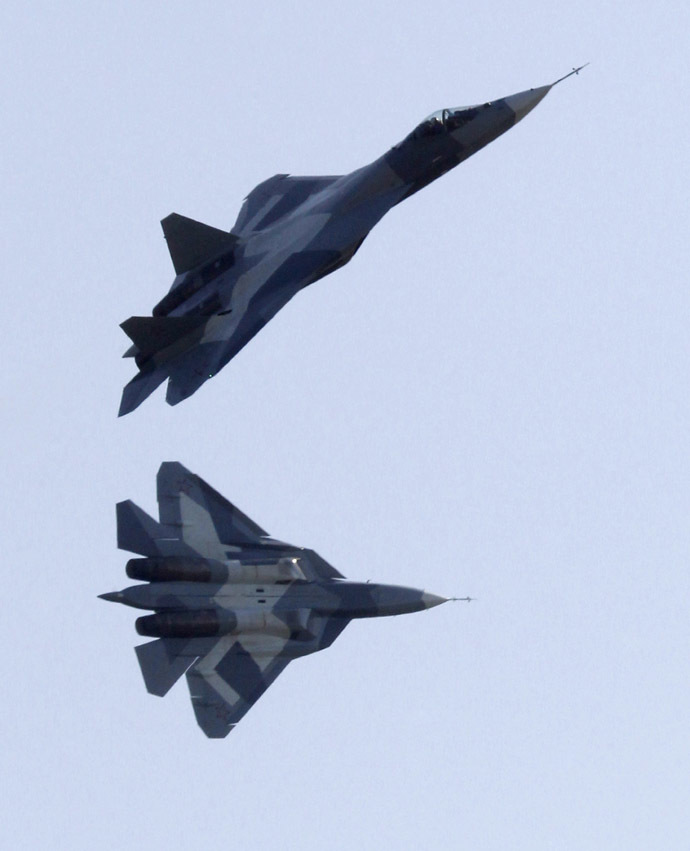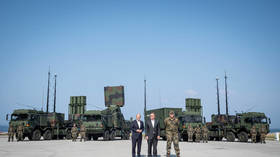Rarefied air: Russian 5G fighters boast cutting-edge life support systems

The Russian Sukhoi T-50 5G fighter jet is equipped with cutting-edge computerized life support systems, including an oxygen station securing unlimited breathing gas supply and advanced pilot’s compensation system that anticipates gravity overload.
The research and development enterprise Zvezda has announced the final tests for its onboard oxygen generation system that will be installed on all Russian operating fighter jets, including those to be supplied abroad, Izvestia daily reports.
Unlike the 90 kilogram oxygen bottles system the new generator weights a mere 30 kilograms, a crucial weight and space economy in modern combat aircraft construction.
“Oxygen is produced from the atmosphere as the system takes it from the engine’s compressors and redirects it to pilot’s mask. Flight time no longer depends on oxygen supply," Zvezda’s Chief Specialist Mikhail Dudnik told Izvestia.
It took five years to shape up the system, Dudnik said, but all four Sukhoi T-50 PAK-FA 5G fighter jets currently undergoing flight tests near Moscow were already manufactured with this system at a Sukhoi plant in Komsomolsk-na-Amure – a city located in Russia’s Far East. The 5G fighters made their way across the country without oxygen tanks onboard.
Soviet and Russian military aviation previously employed oxygen
bottles - an old, but time-tested technology. But it also imposed
certain restrictions on mission duration, because while refueling
was an option for many long-range military jets, oxygen re-supply
was not. So a pilot had to always keep a close eye not only on
fuel, but also the oxygen capacity of his aircraft, as elevations
4 kilometers or higher require a breathable gas supply to avoid
oxygen deficiency. An unexpected leakage of excess oxygen
spending could lead the failure or termination of a vital
mission.
Consequently, every Russian Air Force airfield is now equipped with oxygen producing stations, which must be manned by experienced personnel. Soon such stations will become a thing of the past.

F-22 grounded for months due to oxygen supply
The Sukhoi T-50 PAK-FA’s future major rival in the air, the
American 5G F-22 Raptor fighter jet is equipped with its own
On-Board Oxygen Generation Systems (OBOGS) developed by
Honeywell.
Many modern aircrafts, like the F-22, F-35, B-1B, B-2B,
Eurofighter, Gripen, Nimrod and others are equipped with this
system. But only the F-22 has been plagued by a persistent fault
– a deficiency of oxygen in the cockpit which leads to
hypoxia.
Hypoxia occurs when the brain is starved of oxygen, causing
dizziness, disorientation, blackouts and finally loss of
consciousness. When operating a fighter jet that flies at nearly
twice the speed of sound, even a momentary lapse could lead to
catastrophe.
At least 25 American pilots out of some 200 have reported dizziness, disorientation and other symptoms similar to those associated with hypoxia while flying the F-22 – the world’s most expensive fighter jet – since 2008.

One pilot, Captain Jeff Haney, was killed in a November 2010 plane crash that was believed to have been triggered by a malfunction with his oxygen supply.
The US Air Force admitted that a ‘small number’ of F-22 pilots simply refused to fly the stealth fighter until it is completely safe or have asked to be transferred to operate different planes altogether.
After many months, the F-22s were grounded while technical specialists attempted to improve the situation with pilots experiencing breathing problems and coughing caused by the plane’s oxygen system. In March 2013, US officials finally admitted they had no solution to the problem.
Maj. Gen Charles Lyon, who headed the investigation, told Wired
that “the Air Force will continue to explore further potential
causes through long term breathing air analysis and human systems
integration efforts”, but that it will no longer investigate
claims of coughing fits from F-22 ground crews.
Some PAK-FA wonders: What else is there?

9G antigravity suit
The advanced flying characteristics and super-maneuverability of
Sukhoi T-50 fighter jet exposes pilot to extreme G-forces,
actually reaching the human ceiling limit. A T-50 pilot cannot
actually use the jet to its fullest potential without ultramodern
technical assistance on a variety of fronts.
That is why Sukhoi T-50 fighter jet pilot requires a brand-new
antigravity G-suit capable of compensating up to 9G for an
unprecedented 30 seconds the plane is thrust into a bone-crashing
missile evasion maneuver.
The unique G-suit, developed by the same Zvezda enterprise, allows the pilot to eject from the plane at the height of up to 23 kilometers.
The onboard computer anticipates overload and avoids the delay of
the system response to pressure compensation. The gravity
compensation system calculates everything, from the air pressure
created in the rete of flexible pipes entwisting the G-suit and
supporting the pilot’s body to the 6-7 atmosphere air pumped into
pilot’s lungs to compensate the external chest pressure and
prevent him from blacking out.
“This system is our own know-how, no one in the world has managed to develop such a system so far,” Zvezda’s Chief Specialist Dudnik told Izvestia in early July.
‘Diapers are not for military aviators’
A safe flight is a comfort flight and for military pilots, who are by no means comic book heroes empowered with the ability to fly, must answer nature’s call, particularly during long patrol missions. If there is a pilot that can operate a supersonic fighter at a 20 kilometer altitude for 12 hours straight, performing maneuvers, refuels etc., than he is a true superhero and should be cloned.
Zvezda’s deputy chief designer Nikolay Dergunov informed Izvestia that specially designed underwear is being tested to become an integral part of PAK-FA pilot’s gear.
Some previous generation Soviet fighter jets were first equipped with ‘personal convenience’ systems in the 1990s after pilots flat out refused to use diapers, arguing it was uncomfortable to operate a jet while wearing them. But only on the PAK-FA it is fully integrated into the pilot’s suit and does not divert his attention from the mission.

Golden skies
The PAK-FA pilot is going to be surrounded by gold at all times as NPP Technologia enterprise in Russia’s Obninsk has developed a gold coating for the cockpit which reduces radar’s ability to detect the equipment by 250 times. The coating also protects pilot from high-energy radar pulses and solar radiation.
The coating consists not only of gold, but a combination of various metals, including stanum and indium, applied on the cockpit with a specially developed magnetron installation.
The NPP Technologia enterprise, which also produces the majority of composite elements for the Pak-FA hull, says all systems will are go to supply all future 5G jets with golden cockpits once industrial production of the aircraft starts in 2015.
Modularized electronic system
After the collapse of the 1990s, Russia was lagging behind in the development of digital ‘military and space’ grade electronics. Therefore, developing a 5G fighter jet seemed to be impossible without the complete modernization of electronic production in Russia, both military and civilian, which has indisputably been achieved as evidenced by the performance of the four PAK-FA jets during the test flights.
The Sukhoi T-50 fighter jet onboard information computation has been shifted from the classic multicomputer system to the Integrated Modular Avionic system, a long-anticipated change when a single processor controls many processes aboard, attributing priority level to each process and computing the most critical first, which prevents PAK-FA’s computer from freezing.
It has been an absolute precondition that the Russian 5G fighter jet will be using only domestically-produced electronic components and to achieve this objective, the Russian electronics industry was forced to undergo a revolution which ultimately proved successful.














